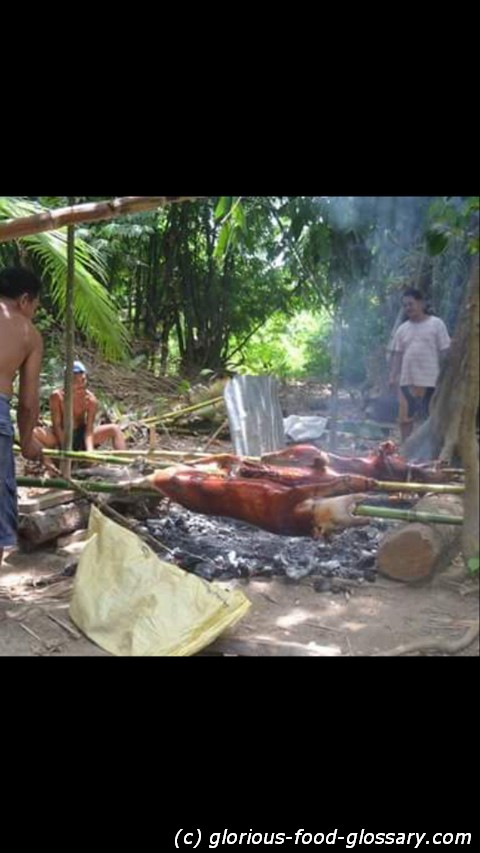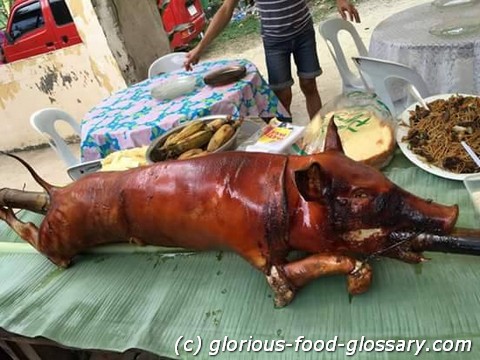Lechon is a mouthwatering and iconic dish that is synonymous with celebration and feasting in many parts of the world. It is a flavorful and succulent roasted pig, often prepared whole, and is known for its crispy, golden-brown skin and tender, juicy meat. Lechon is a cherished delicacy in various cultures and is prepared using a variety of seasonings and cooking methods to achieve its signature taste and texture.
Application Areas: Lechon is enjoyed in a wide range of contexts and celebrations, including:
-
Festivals: Lechon is a centerpiece at many festivals and special occasions, where it symbolizes abundance and joy.
-
Family Gatherings: It is a popular choice for family gatherings, birthdays, and holidays, serving as a communal and indulgent feast.
-
Weddings: Many wedding receptions feature a whole roasted pig as a sign of prosperity and a delicious treat for guests.
Well-Known Examples: Lechon is prepared in various ways across different cultures, and each has its own unique flavor profile. Some well-known examples include:
-
Lechon Baboy (Philippines): Filipino-style lechon is often seasoned with a mixture of garlic, lemongrass, and spices before being roasted over an open flame.
-
Lechón Asado (Cuba): Cuban lechon is marinated in a tangy citrus and garlic mixture before being slow-roasted to perfection.
-
Cochinillo Asado (Spain): Spanish cochinillo asado is a delicacy that features a young suckling pig seasoned with salt and roasted in an oven.

Recipe: Filipino Lechon
- Clean and gut the pig, removing any innards.
- Marinate the pig inside and out with a mixture of lemongrass, garlic, salt, pepper, soy sauce, and fish sauce.
- Skewer the pig onto a large bamboo stick or metal rod, securing it for roasting.
- Roast the pig over an open flame or in a specially designed lechon pit for several hours, continuously basting it with the marinade until the skin is crispy and the meat is tender.
History and Legal Basics: The tradition of cooking and serving whole roasted animals, including pigs, has deep historical roots in various cultures. While there are no specific legal regulations governing lechon, food safety and hygiene standards apply to its preparation and handling.
Examples of Sentences:
- The aroma of lechon filled the air as the family gathered for the holiday feast.
- He learned the art of lechon preparation from his grandparents, who passed down their treasured recipe.
- The lechon was the star of the wedding banquet, drawing admiration and delight from the guests.
- In some cultures, lechon is a symbol of good fortune and prosperity.
- She savored every bite of the crispy lechon skin, a testament to the skill of the cook.
Similar Terms and Synonyms:
- Roast Pig
- Suckling Pig
- Porchetta
- Caja China (Roasting Box)
- Pernil (Puerto Rican Roast Pork)
Articles with 'Lechon' in the title
- Lechon al Horno: Lechon al Horno : Lechon al Horno refers to a Bolivian dish which consists of a roasted pig served with fried plantains and sweet potatoes and usually served as a main meal
- Lechon Paksiw: Lechon Paksiw also called Paksiw na Lechon is a dish from the Philippines usually made from lefover Lechon (roasted pig). Lechon Paksiw is a Filipino stew whose essential ingredient is Suka (Vinegar), the chopped meat from the leftover . . .
Summary
Lechon is a revered dish in various cultures, characterized by the roasting of a whole pig to achieve crispy skin and tender meat. Whether prepared for festive occasions or family gatherings, lechon symbolizes abundance and joy, delighting food enthusiasts with its rich flavors and cultural significance. Different regional styles and seasonings contribute to the diversity of this beloved dish, making it a culinary treasure enjoyed by people around the world.

Related Articles to the term 'Lechon' | |
| 'Lechong Baboy' | ■■■■■■■■■■ |
| Lechong Baboy in the food context refers to a traditional Filipino dish of roasted whole pig. It is renowned . . . Read More | |
| 'Lechong Liempo' | ■■■■■■■■■ |
| Lechong Liempo in the food context refers to a Filipino dish that consists of roasted or grilled pork . . . Read More | |
| 'Peiching hsun chi' | ■■■■■■■ |
| Peiching hsun chi refers to a famous Northern foul Peking dish which is also known as is Smoked Chicken. . . . Read More | |
| 'Schweinshaxe' | ■■■■■■ |
| Schweinshaxe is a traditional German dish consisting of a roasted pork knuckle or shank. This dish is . . . Read More | |
| 'Puerco' | ■■■■■■ |
| Puerco refers to pork, the culinary name for meat derived from domestic pigs (Sus scrofa domesticus). . . . Read More | |
| 'Trotter' | ■■■■■■ |
| Trotter refers to the foot of a pig, cow, or sheep, used in cooking various traditional dishes around . . . Read More | |
| 'Grouper' | ■■■■■■ |
| Grouper refers to a variety of fish species that are part of the subfamily Epinephelinae. Groupers are . . . Read More | |
| 'Breading' | ■■■■■■ |
| Breading in the food context refers to the process of coating food, typically meat, Fish, or vegetables, . . . Read More | |
| 'Croissant' at travel-glossary.com | ■■■■■ |
| Croissant in the travel context refers to a popular and iconic French pastry that has become synonymous . . . Read More | |
| 'Cabrito' | ■■■■■ |
| Cabrito is a culinary term that refers to young, tender goat meat, particularly from a kid (young goat) . . . Read More | |
